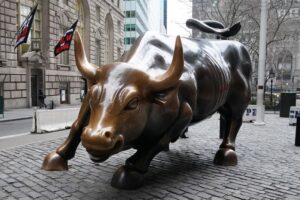The Latest on U.S. Economic Performance: What Investors Need to Know
Recent reports on the U.S. economy have left investors in a state of uncertainty, with the latest figures suggesting a less-than-rosy outlook. While a GDP contraction of 0.3% in the first quarter of 2023 raised eyebrows, it’s essential to dig deeper into the underlying factors—and what they might mean for the investment landscape.
The Read Between the Lines
At first glance, the contraction in GDP—a first since 2022—sparked turmoil in the stock market. However, some economists remain cautiously optimistic. The spike in imports, largely driven by businesses rushing to stock up before tariffs escalated, played a significant role in this decline. Analysts expect these dynamics to shift in the coming months, potentially revitalizing growth.
Matthew Miskin, co-chief investment strategist at John Hancock Investment Management, observed, “There’s just massive distortion and volatility in the economic data right now because of the pull-through of tariffs.” The prevailing sentiment is that investors may grapple with distorted information while attempting to gauge the real health of the economy.
Tariffs: The Double-Edged Sword
The complicated landscape created by President Trump’s tariff policies continues to loom large. The record increase in imports (up by 41.3%) exacerbated the trade gap, which sliced off an astonishing 4.83 percentage points from GDP. This not only instills caution among investors but also complicates decision-making for the Federal Reserve, as inflationary pressures increasingly weigh on monetary policy.
“Reports like this don’t give us a lot of useful data,” said Mark Hackett, chief market strategist at Nationwide. The lack of clarity contributes to a precarious atmosphere for long-term investors, leading many to feel vulnerable to the next twist in an ongoing trade saga.
Consumer Spending: A Bright Spot
Despite the gloomy statistics, there’s a silver lining: consumer spending, which makes up over two-thirds of the economy, grew at a respectable rate of 1.8%. Larry Werther, chief U.S. economist of Daiwa Capital Markets America, expressed that while recession is not his base assumption, the chances of one occurring in the next twelve months have notably increased.
“We need to monitor consumer behavior,” Werther added. “If spending falters, we may be faced with a bigger problem.”
Market Response and Investment Strategies
Initially, stock futures took a heavy hit post-report but subsequently rebounded, with the S&P 500 ultimately closing slightly higher. However, it remains approximately 9.4% below its February peak. Treasury yields reflected mixed reactions, with two-year U.S. Treasury yields falling amid expectations of potential rate cuts as the economy slows.
Robert Tipp, chief investment strategist at PGIM Fixed Income, noted that the long end of the yield curve reflects growing concern for growth, which could force the Fed to prioritize economic support, even while battling inflation.
As investors survey this mixed economic signal, many are opting for a more cautious strategy. As Sonu Varghese from Carson Group suggested, a “barbell” approach—balancing between defensive, low-volatility stocks and high-growth equities—might offer a well-rounded portfolio in unpredictable times.
Upcoming Indicators
Investors should keep an eye on upcoming economic indicators, particularly the U.S. employment report set to be released soon. “Right now, consumption is still holding the economy together,” Varghese states, but warns that any signs of labor market weakening could signify deeper issues ahead.
Conclusion
With ongoing tariff negotiations casting a long shadow over economic data, staying informed and adaptable is crucial for investors. At Extreme Investor Network, we emphasize monitoring these shifts and nuanced indicators that dictate market movements. As the landscape continues to change, those who adapt their strategies to the evolving economic environment will be best positioned for success.
Invest wisely—and stay tuned for more in-depth analysis on navigating this volatile market.

